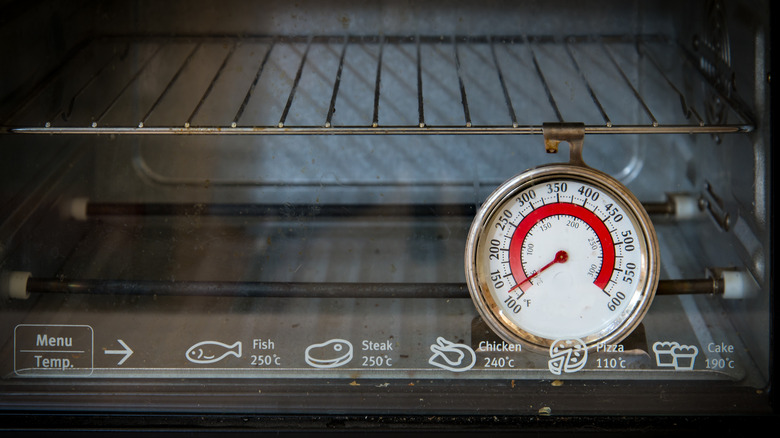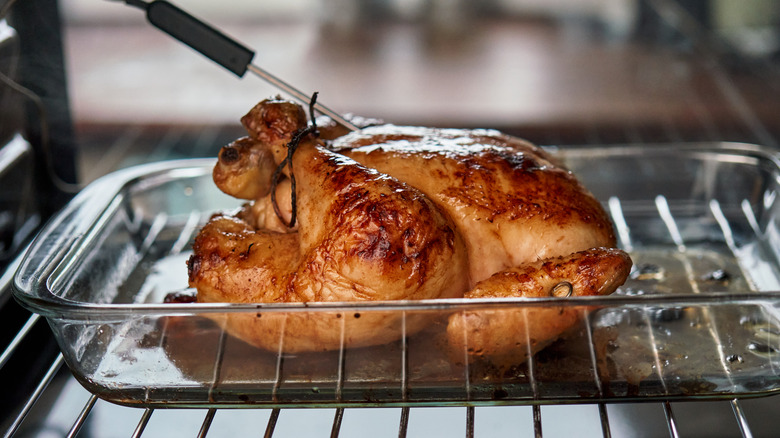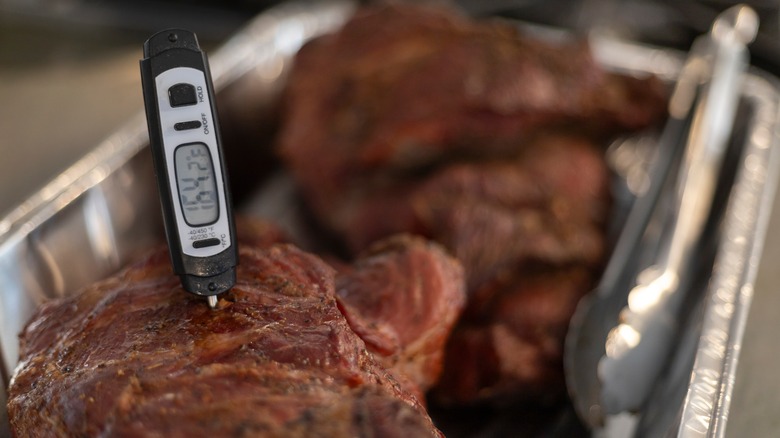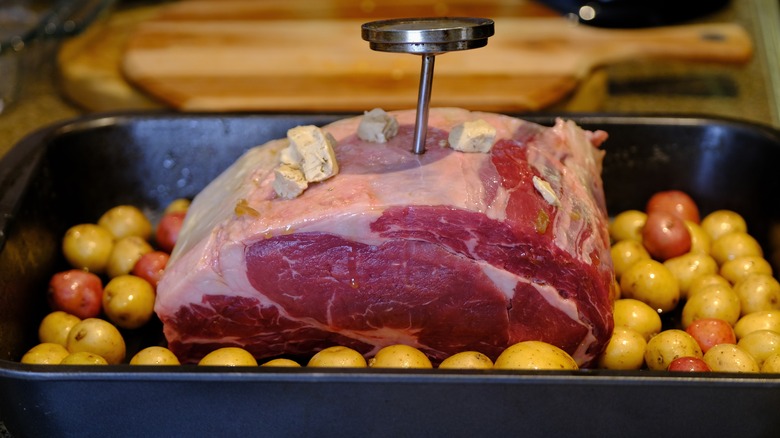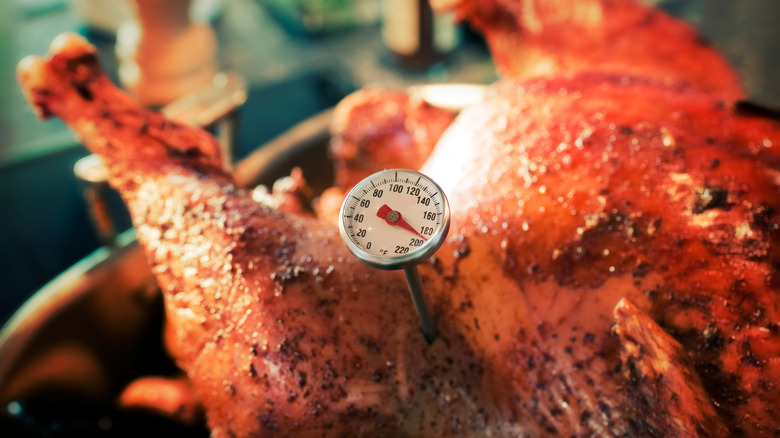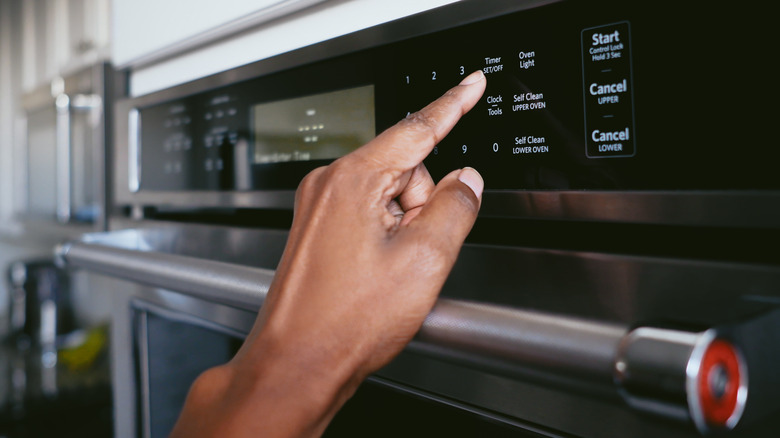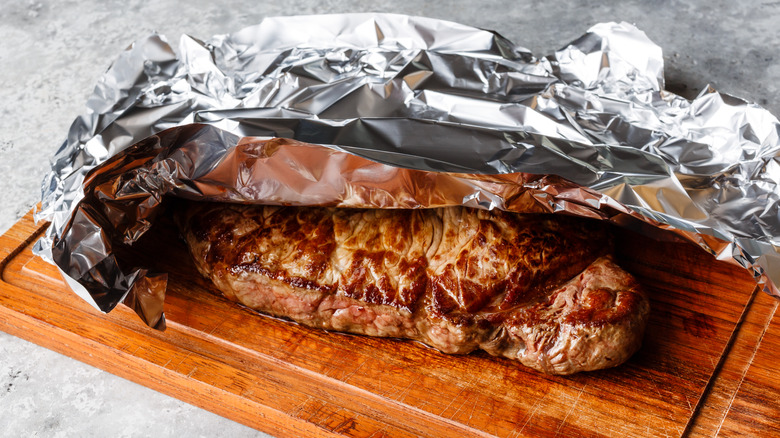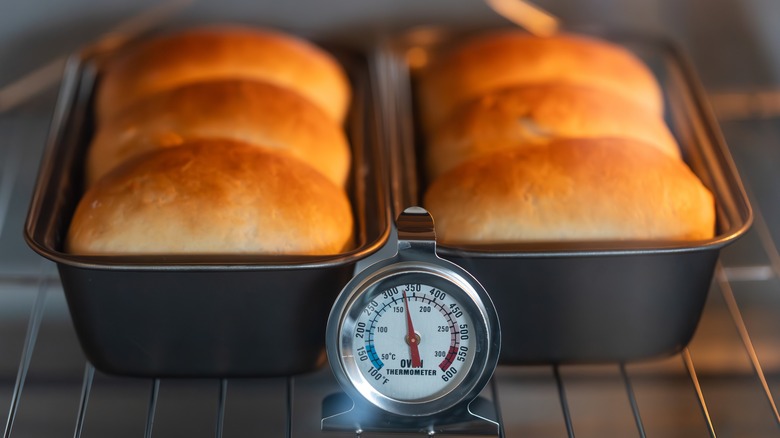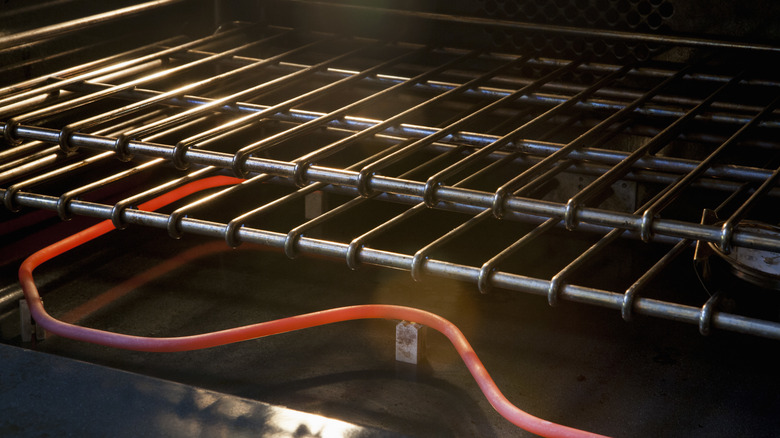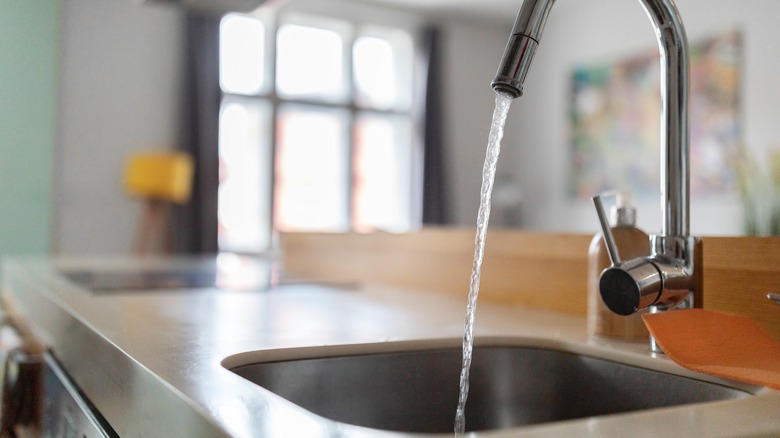9 Tips For Using An Oven Thermometer The Right Way
We may receive a commission on purchases made from links.
If you're interested in cooking your food to a specific temperature, a trick most often associated with making the perfect steak, chances are you've researched or even purchased an oven thermometer. They come in digital as well as analog varieties that show temperature in Fahrenheit, Celsius, or both. They can also have range displays to help you remember which temperatures are safe for various types of food, including fish, poultry, and red meat. Some clip directly onto the oven's surface, while others are used with a particular dish or food with a probe that inserts into the food — but once you have this helpful kitchen gadget, how exactly do you use it?
Sometimes called a probe thermometer, this small tool is perfect to monitor how your food is doing in the oven without interfering with the actual cooking process. Some do this by keeping track of the air temperature, while others go directly into your dish to measure the internal temperature of the food. These thermometers help prevent overcooking, which can taste bad, or undercooking, which poses a food safety issue.
Scott Groth, a chef and pro food blogger at I'd Rather Be A Chef, shared his tips for making the most of this tool. "The oven thermometer is great to use because it monitors the temperature in real time," he said. "Knowing the exact temperature allows for more precise cooking, resulting in perfectly done dishes rather than overcooked disasters."
Leave the thermometer alone
If you're using a thermometer that goes into your food, it's important to set it and leave it alone. This is one of the most important tips when it comes to effective kitchen thermometer use, especially when you use it with meat. Poking and prodding your meat multiple times while cooking lets the juices flow out, so you want to avoid wiggling or adjusting the thermometer as much as possible. Just place the meat thermometer and let it be, checking it periodically without moving it.
"Once the thermometer is inserted, it's a good idea to just leave it alone," said Scott Groth. "Poking multiple holes into meat allows all the fats and juices to run out of the dish. This increases the risk of the dish drying out."
Tools that measure the air temperature in your oven should also be left alone as much as possible. These thermometers are typically placed on the rack or just inside the door to measure the temperature of the oven environment. Every time that you open the oven to check, however, air moves in and out of the oven. This changes the temperature and can result in an inaccurate reading that fluctuates. This also makes it harder to keep track of what temperature your food is cooking at when it is in the oven. Depending on how much the environment cools each time you open the door, it can significantly cool the cooking process and even delay your final dish.
Don't measure the bone
If you are using your probe thermometer with bone-in cuts of meat, make sure that the thermometer stays away from the bone. It can interfere with the measurement and ultimately give you a false picture of your food. Insert your thermometer before you put the meat in the oven, which allows you to see exactly where the bone is located and to be very intentional with the placement. Follow the same rules when cooking poultry, avoiding the ribs and bones. The inside of the thigh is a good option that has plenty of muscle for the thermometer to measure in without getting close to bone.
"Keep in mind that bones conduct heat differently than the meat, which will lead to an inaccurate reading," said Scott Groth. "This will make it seem like the meat is at a safe temperature when it is actually undercooked."
If your food is underdone, you're likely to discover this once you cut into it. For meat, this means letting the juice out of the cut and potentially having to put it back in the oven if it is significantly undercooked. Not only does this mean less flavor, but it can also result in drier meat since a lot of the juices were let out.
Look for muscle, not fat
Just like the bone can give an inaccurate reading, the fat portion is also not a great place to measure when you cook. Try not to put the thermometer is the fatty parts of the meat, since it can heat faster than the rest of the cut. When cooked, fat also liquefies, which can make the thermometer less stable when placed in a large section of fat.
"Fat renders more quickly than the meat, conducting the heat differently than the more dense meat," said Scott Groth. "This will also lead to a reading that looks safe when the meat will most likely be undercooked."
For the best results, monitor the temperature of the muscle by inserting the tool where you see red or pink raw meat. Put it around halfway into the cut so that it measures at the center, which is generally the coolest portion of the meat. Once it reaches the desired level, the surrounding portions will be at that temperature as well.
For meat with a lot of marbling, don't worry about avoiding fat completely. Just try to pop the tool in a part of the meat that has more muscle than fat. The meat should feel substantial and provide some resistance when you insert the probe. Fat is much looser and will have a distinctly different texture when you try to place the thermometer.
Aim for the thickest part
You should measure the internal temperature of your cut at its thickest point. Most thermometers measure the temperature at the tip of the probe and the readings will reflect the temperature at this point. The thickest part of the food is the last to heat up to temperature, so inserting your tool at this point gives you the most accurate results. This ensures that your food is completely cooked to your desired level and will help you avoid food safety issues that come with undercooked meat.
The exact location depends on the type and cut of meat, but Scott Groth provided a general rule of thumb. "For roasts, steaks or roulades, placing the probe in the thickest section will lead to the best results," he said. "For poultry (chickens, turkeys, ducks etc.), the best location will be on the inner thigh." Don't forget to also avoid the bone, which can sway your results, and look for the thickest section that just includes muscle.
Keep in mind that getting an evenly cut steak is also important, especially if you have very specific preferences between rare, medium, and well done. For poultry, going with a whole bird makes measuring a little bit easier, although you can apply the same idea to pieces like chicken breasts or thighs. Just be sure to avoid the bone if you have a bone-in cut.
Calibrate periodically
When cooking, you should always check to make sure that your tools and appliances are measuring correctly. An inaccurate thermometer that measures too high will tell you that your food is done cooking when it isn't, leading to undercooked dishes and potential food safety hazards. On the other hand, if the reading is lower than the actual temperature, you might end up overcooking and drying out your food.
Fortunately, you can keep up the thermometer itself by periodically comparing it to boiling water to see if the measured temperature matches the known boiling point of water.
"The fastest and easiest way to know if your thermometer is calibrated properly is to place it in boiling water. It should register 212 degrees Fahrenheit or 100 degrees Celsius," said Scott Groth. "This is a great way to know that your readings are going to be accurate."
An oven thermometer is also a useful tool to keep around to monitor the temperature of the oven itself. If you set your oven to a specific level, but the thermometer's reading is a few degrees off, you might need to compensate for this difference when cooking. This is especially important in baking, where temperature plays a critical role in how ingredients come together and how well certain dishes rise. The difference in set temperature and actual temperature is called "offset," which you can include when you choose the temperature to set your appliance.
Place the thermometer before cooking begins
To make sure that it's placed properly and to avoid potentially burning yourself, insert the oven thermometer in its spot before you put your food in the oven. This ensures that you won't need to reposition it while cooking. Don't take it out of the food until it has had a chance to rest post-cooking.
For food like chicken and turkey, Scott Groth recommends sticking it in the meatiest part from the beginning and leaving it there until well after your food is done in the oven. "The thermometer should be placed in the poultry before the cooking starts," he said. "Once the poultry is five degrees from being cooked through, it can be removed from the oven. It will continue to 'carryover cook' for 10 to 12 minutes while the meat rests and will reach the desired doneness."
Steaks and other cuts of red meat benefit from the same strategy. "Just like with poultry, it is best to remove the dish from the oven slightly before it has reached the desired temperature as the residual heat will carryover and continue cooking the meat as it is resting," says Groth. Don't remove the probe or cut into the meat while it is resting, as this lets the juice out of the meat. Instead, wait for between 5 and 10 minutes for the meat to re-absorb the flavorful liquid.
Use for casseroles and baking
Oven thermometers aren't just for meat. If you're cooking for a large group, you can use a probe thermometer to assess the doneness of casseroles, quiches, and eggs. It is also helpful to monitor the oven environment when baking.
"At my catering company, we used the oven probes for large batches of breakfast strata, egg bakes, and more," said Scott Groth. Just place the tool in your food just like you would meat and wait for it to reach the desired temperature. The U.S. Department of Agriculture (USDA) recommends a minimum temperature of 160 F for egg-based dishes. When cooking large batches, using a thermometer cuts down on time needed to continuously monitor.
You can also check the accuracy of your oven's temperature sensors before you even begin cooking, which can make a big difference with your baking. By adding an oven thermometer to keep track of the air temperature around items like bread or muffins, you can keep closer track of how done they are without breaking them apart. While inserting a thermometer into cuts of meat works to monitor the internal temperature, you can't use the same technique with dough or batter. Instead, place an oven thermometer on the rack nearby to measure the external temperature in your appliance. If you have noticed that your baked goods are not turning out as expected, especially if they seem underdone, using an oven thermometer to accurately measure the temperature is a great step to better baking.
Keep away from heat coils
Anytime you're working with high heat in the kitchen, it's important to follow recommended safety precautions to avoid getting burned. Using an oven thermometer requires careful movements, as you will be around high heat and tools that get hot. Make sure that your thermometer stays away from the heat coils in the oven to prevent safety issues. This is especially important if your probe has wires of its own, as contact between the wires and the heating element can damage both the thermometer and the oven. If you've placed the thermometer in your dish or on the oven's rack before turning it on, you might need to adjust it slightly to keep it away from the coils.
You should also handle your hot tool with care when taking it out of the meat. "When removing the probe from meat, I like using heat resistant oven gloves that have fingers rather than an oven mitt," said Scott Groth. "I have found that the best way to stay safe is to hold the meat with a set of tongs with one hand and use the oven glove to gently remove the thermometer with the other." You can find gloves made of silicone that are heat-resistant as well as pliable, allowing you to handle the hot thermometer while maintaining a good grip. It's generally a good idea to keep your oven mitt or gloves handy from start to finish when cooking.
Clean thoroughly
The oven thermometer needs a few minutes to cool, but you should make sure to clean it before putting it away. This prevents the potential spread of bacteria that can make you sick. "Once the probe has been removed, I place it directly in the sink to cool and be washed so it can be put away quickly," said Scott Groth. Remember that the oven probe is hot, so keep it away from plastic dishes or utensils that might melt if in direct contact with this piping hot tool from the oven.
To clean an oven thermometer, just wash it with warm soapy water, rinse, and dry. You can let it air dry in a rack overnight or dry it with a towel, then put it away. Some thermometers have cases to protect delicate parts, especially those with probes and wires. Make sure that the thermometer is completely dry before putting it back into a storage case.
If you're new to this tool, look for an oven thermometer made of durable materials, such as stainless steel. A good thermometer is wipeable and can be hand-washed to keep it clean. Most options aren't dishwasher safe and should be washed by hand. If you take care of this step right away, it will increase the longevity of your tools.
